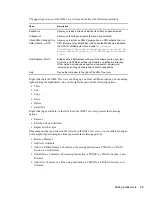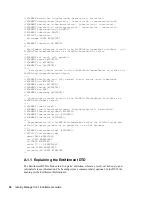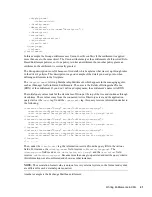
Writing Entitlements in XML
43
no
vd
ocx
(e
n)
13
Ma
y 20
09
A.2.3 Example 3: Administrator-Defined Entitlement: With Lists
The third example is an admin-defined entitlement that creates a grant or revoke event after you
select a list entry.
<?xml version="1.0" encoding="UTF-8"?>
<entitlement conflict-resolution="union"
description="This will show Administrator-defined Values">
<display-name="Admin-defined Entitlement"/>
<values multi-valued="true">
<value>Building A</value>
<value>Building B</value>
<value>Building C</value>
<value>Building D</value>
<value>Building E</value>
<value>Building F</value>
</values>
</entitlement>
In this example, the entitlement name is
Admin-defined
, with a defined display name of
Admin-
defined Entitlement
. (You only need to put in a display name if you want the display name to be
different from the entitlement’s RDN.) The conflict resolution line shows the setting of Union,
which allows the entitlement to merge the values that are assigned.
The Entitlement description is
This will show Administrator-defined Values
. The multi-
valued attribute is set to true, which allows the entitlement to assign a value more than once. In this
example, the values are corporate building letters: Building A through Building F. Then, through an
entitlement client such as an iManager Roles-Based Entitlement task or through the User
Application, users or defined-task managers can specify the building information, which is then
included in an external application, such as Novell eDirectory
TM
.
A.2.4 Example 4: Administrator-Defined Entitlements: Without
Lists
The fourth example is an admin-defined entitlement that forces the administrator to type a value
before the entitlement can grant or revoke an event. You can use this kind of entitlement if you do
not have all of the information to create a task list at the initial setup.
<?xml version="1.0" encoding="UTF-8"?>
<entitlement conflict-resolution="priority"
description="There will be no pre-defined list">
<values multi-valued="false"/>
</entitlement>
In this example, the entitlement name is
Admin-defined
(no list), and it uses the entitlement name
as the displayed name because there is no display name entry. The conflict resolution is again set to
the default of Priority, which means that if the entitlement is used by Role-Based Entitlements, the
RBE with priority sets the value. Through an entitlement client, such as an iManager RBE task or
through the User Application, you specify the building information, which is then included in an
external application, such as eDirectory.
Содержание IDENTITY MANAGER 3.6.1 - ENTITLEMENTS
Страница 4: ...4 Identity Manager 3 6 1 Entitlements Guide novdocx en 13 May 2009...
Страница 6: ...6 Identity Manager 3 6 1 Entitlements Guide novdocx en 13 May 2009...
Страница 8: ...8 Identity Manager 3 6 1 Entitlements Guide novdocx en 13 May 2009...
Страница 12: ...12 Identity Manager 3 6 1 Entitlements Guide novdocx en 13 May 2009...
Страница 26: ...26 Identity Manager 3 6 1 Entitlements Guide novdocx en 13 May 2009...
Страница 44: ...44 Identity Manager 3 6 1 Entitlements Guide novdocx en 13 May 2009...


































